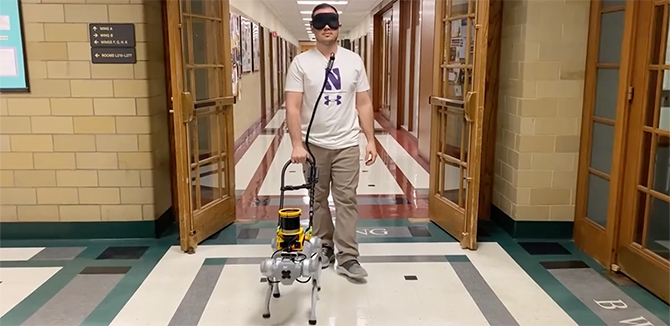Meet Willie, The Autonomous Guide Dog
Marthinus Nel (MSR ‘23) was inspired by a friend who has epileptic seizures to create a robot pal that helps those with visual impairments.

Willie is a good dog.
As a guide dog, Willie can steer a human with visual impairment around obstacles and stop safely if danger is approaching.
But unlike traditional guide dogs, Willie can do much more while requiring no food or water. Plus, Willie doesn’t care if you can give a good belly rub.
Willie is the autonomous guide dog created by Marthinus (Marno) Nel (MSR ‘23), a student in Northwestern Engineering's Master of Science in Robotics (MSR) program, for his independent project.
“I decided to do this project after someone close to me started having epileptic episodes,” said Nel, who knew nothing about guide dogs before beginning the course. “After investigating guide dogs, I identified a few shortcomings, namely that they are red and green color blind and they do not grasp street laws and signs.”
Nel’s project aimed to increase user safety and ease the burden on the guide dog industry, which is beset by long waits between when a person needs a helpful four-legged friend and when one is trained and available.
There also is the cost factor: A guide dog can cost between $20,000-$40,000 to train and use, Nel discovered during his research.
Nel created WIllie to provide a better guide-dog experience. Nel’s guide dog uses 360 light detection and ranging (Lidar) to help its human avoid obstacles, an Intel camera to learn and remember how different objects look, and deep learning along with a speaker and microphone to bypass pesky and vague barks in favor of native-language speech.
“I wanted to add a new layer to the dog," Nel said, "where it can see objects and recognize what they are and then convey that through speech-to-text to the owner.”
The goal, Nel said, is to give users a better understanding of their surroundings. So, for example, if the duo is approaching a set of stairs, Wilie is able to clearly communicate what is coming. Willie can also learn people’s faces and understand what street signs are saying and relay that information to his pal.
The communication goes two ways. The microphone allows the human to give the dog commands such as “walk faster” or “stop.” The goal is to make WIllie unfailingly obedient.
Not surprisingly, creating Willie was no easy task. Reliability and consistency were both challenges.
“One test would go perfect and the next one would not work at all, with the robot just frozen in place when instructed to navigate to a location,” Nel said. “This took a lot of time and coding to improve and ultimately fix.”
Fix it, he did. By the end of the 10-week project, which aims to give MSR students the freedom to work on a subject of interest to them, Nel took a generic robot dog and developed it enough that he could blindfold himself and trust it to guide him around a room.
That transformation increased Nel's confidence in his abilities — and himself.
“I learned that no matter what robotic system is put in front of me, I can figure out how it works and improve it,” he said.
That newfound confidence has Nel excited about the rest of his time in the MSR program and the career that awaits him after graduation.
“I gained valuable experience in programming autonomous systems and quadruped robots that I will apply to my final project, which is also a fully autonomous system,” he said. “I would like to improve on this project in the future and give power and freedom to visually impaired people through robotics.”

